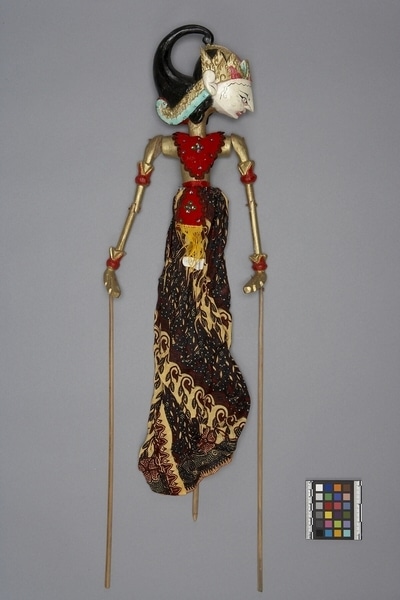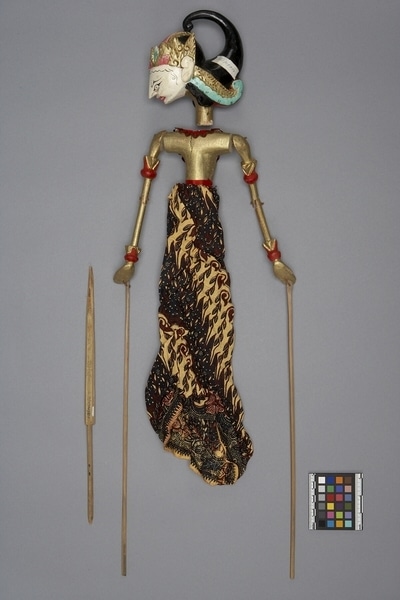Rod Puppet Item Number: Ib404 a-c from the MOA: University of British Columbia


Description
Three-dimensional male humanoid puppet: large head (part b) fits into body with skirt (part a), and a control rod (part c) with a long shaft that passes through the body and fits into the neck of the figure's head. The body has jointed arms, each with a long controlling rod attached. White face positioned downwards: delicate eyes, other facial features outlined in black. Red lips and white teeth. Large curl (gelung supit urang) headdress with diadem and long sumping in black, gold, green, and red. Gold neck and torso; arms have gold and red ornaments at wrist and bicep. Red chest covering and apron, with red trim and green and blue sequins. Apron with yellow frills at bottom, red waistband. Long batik skirt (blue and red on beige). Two pieces of lined paper with handwritten (in pen) inscription 'Abimanyu' glued to headdress and skirt.
History Of Use
Javanese puppetry as an art form probably developed by the 11th century. Wayang golek puppets of western Java appeared during the 16th century. Originally the plays depicted Javanese mythology, but after the Indian conquest of Java the Hindu epics, Ramayana and Mahabharata, were incorporated into the cycles, which comprise about 200 plays. A dalang (puppet master) performs the plays to celebrate important occasions, usually in three acts, with vocal and instrumental accompaniment. Typically they serve a moral and religious purpose, and more recently, one of political commentary. Abimanyu is a prince (raden) from the Mahabharata cycle. He is the son of Arjuna, one of the principle Pandawa brothers. Puppet may not be correctly identified.
Cultural Context
Theatrical performance.
Iconographic Meaning
Each puppet is characterized by its wanda, a Javanese word which describes the specific mixture of elements of size, form, colour, ornamentation and carving. Colour and position of face suggest high virtue. Small facial features are very refined; position of hands, batik skirt, headdress, and skin colour indicate high rank. Inscription suggests Abimanyu, but puppet seems a great variation (much less hair, simpler headdress; moustache; larger eyes). Not otherwise identified.
Item History
- Made in Java, Indonesia
- Owned by Donald Bone before January 4, 1980
- Received from Donald Bone (Seller) and Museum of Anthropology Donations Fund (Funding source) on January 4, 1980
What
- Name
- Rod Puppet
- Identification Number
- Ib404 a-c
- Type of Item
- puppet
- Material
- cotton fibre, paint, fibre and wood
- Manufacturing Technique
- carved, woven, sewn, painted and tied
- Part C
- height 38.0 cm, diameter 1.5 cm
- Part B
- height 16.0 cm, width 7.5 cm, depth 14.0 cm
- Part A
- height 66.0 cm, width 15.0 cm, depth 7.0 cm
Who
- Culture
- Sundanese
- Previous Owner
- Donald Bone
- Received from
- Donald Bone (Seller) and Museum of Anthropology Donations Fund (Funding source)
Where
- Holding Institution
- MOA: University of British Columbia
- Made in
- Java, Indonesia
When
- Ownership Date
- before January 4, 1980
- Acquisition Date
- on January 4, 1980
Other
- Condition
- good
- Accession Number
- 0586/0024 a-c